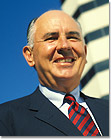|
January - June 2005
Nariman Farvardin
Professor and Dean
Clark School of Engineering
 Dear Clark School Friends, Dear Clark School Friends,
The pace of change at the Clark School has reached a remarkable level. When I wrote this article in December of 2004, I identified positive trends for the "months and years ahead."
As you'll see, I should have said "weeks ahead."
Trend: Accelerating Support
 In early February we announced A. James Clark's $30 million Clark Scholarship Endowment, the largest gift in the school's history, which provides Clark School undergraduates specific scholarships based on merit, need and diversity. The endowment is already having a significant impact, allowing us to reduce or eliminate financial barriers for many more students, compete more successfully for the very best students and inspire the interest of students who might not otherwise consider engineering. Our incoming freshman class is larger and more diverse than last year and by all measures the most talented ever, with 50 percent scoring between 1270 and 1420 on the SAT—a 20-point increase from last year. In early February we announced A. James Clark's $30 million Clark Scholarship Endowment, the largest gift in the school's history, which provides Clark School undergraduates specific scholarships based on merit, need and diversity. The endowment is already having a significant impact, allowing us to reduce or eliminate financial barriers for many more students, compete more successfully for the very best students and inspire the interest of students who might not otherwise consider engineering. Our incoming freshman class is larger and more diverse than last year and by all measures the most talented ever, with 50 percent scoring between 1270 and 1420 on the SAT—a 20-point increase from last year.
Trend: Faculty, Student and Alumni Excellence
 Shortly thereafter, we learned that Mr. Clark was named to the National Academy of Engineering, and thus began a string of remarkable honors for Clark School alumni: Edward A. Miller, '50 and James W. Plummer, '53, were awarded the prestigious Draper Prize; Michael Griffin, Ph.D. '77 was named NASA Administrator; Gordon England '61, was nominated as Deputy Secretary of Defense; and Jeong H. Kim, '91, was appointed president of Bell Labs and named one of the top 10 most influential Asian Americans in business. As a further development, we will induct Mr. Miller and Mr. Plummer into our Innovation Hall of Fame at the Kim Building Dedication on September 19, 2005. Shortly thereafter, we learned that Mr. Clark was named to the National Academy of Engineering, and thus began a string of remarkable honors for Clark School alumni: Edward A. Miller, '50 and James W. Plummer, '53, were awarded the prestigious Draper Prize; Michael Griffin, Ph.D. '77 was named NASA Administrator; Gordon England '61, was nominated as Deputy Secretary of Defense; and Jeong H. Kim, '91, was appointed president of Bell Labs and named one of the top 10 most influential Asian Americans in business. As a further development, we will induct Mr. Miller and Mr. Plummer into our Innovation Hall of Fame at the Kim Building Dedication on September 19, 2005.
Trend: Increased Prominence in National Affairs
 In April the Master of Engineering and Public Policy program, which we offer jointly with the School of Public Policy, held its first event, a panel on the future of energy and energy engineering. The discussion featured nationally prominent speakers: William Wulf, president of the National Academy of Engineering; Katherine Sierra, vice president of infrastructure at the World Bank; Michael Ramage, chair of the National Research Council report "The Hydrogen Economy" and retired Executive Vice President, ExxonMobil Research and Engineering Company; and Curtis Bolton, Director of the Next Step Option Program in the U.S. Department of Energy Office of Fusion Energy Sciences. We anticipate many more opportunities to lead national discussions of engineering's role in society. In April the Master of Engineering and Public Policy program, which we offer jointly with the School of Public Policy, held its first event, a panel on the future of energy and energy engineering. The discussion featured nationally prominent speakers: William Wulf, president of the National Academy of Engineering; Katherine Sierra, vice president of infrastructure at the World Bank; Michael Ramage, chair of the National Research Council report "The Hydrogen Economy" and retired Executive Vice President, ExxonMobil Research and Engineering Company; and Curtis Bolton, Director of the Next Step Option Program in the U.S. Department of Energy Office of Fusion Energy Sciences. We anticipate many more opportunities to lead national discussions of engineering's role in society.
Trend: Rapid Growth in Nano and Bio
 In the May/June issue of Small Times magazine, Maryland's nano research and education program (the Maryland Center for Integrated Nano Science and Engineering, or M-CINSE) was ranked first in the nation based on our integrated approach, our large and growing faculty, high productivity in publishing, numerous research grants, associated Kim Building facilities and related undergraduate and graduate courses. Maryland's microtechnology research was ranked second in the nation. In the May/June issue of Small Times magazine, Maryland's nano research and education program (the Maryland Center for Integrated Nano Science and Engineering, or M-CINSE) was ranked first in the nation based on our integrated approach, our large and growing faculty, high productivity in publishing, numerous research grants, associated Kim Building facilities and related undergraduate and graduate courses. Maryland's microtechnology research was ranked second in the nation.
Add to these our important recent achievements in entrepreneurship—the launch of our new VentureAccelerator program and the selection of our Maryland Industrial Partnerships program for the U.S. Small Business Administration's national "Best Practice" award for technology transfer—and you complete the picture of an engineering school rapidly on the rise. Based on recent experience, that picture will only be enhanced in the weeks to come.

Nariman Farvardin
Professor and Dean
|

